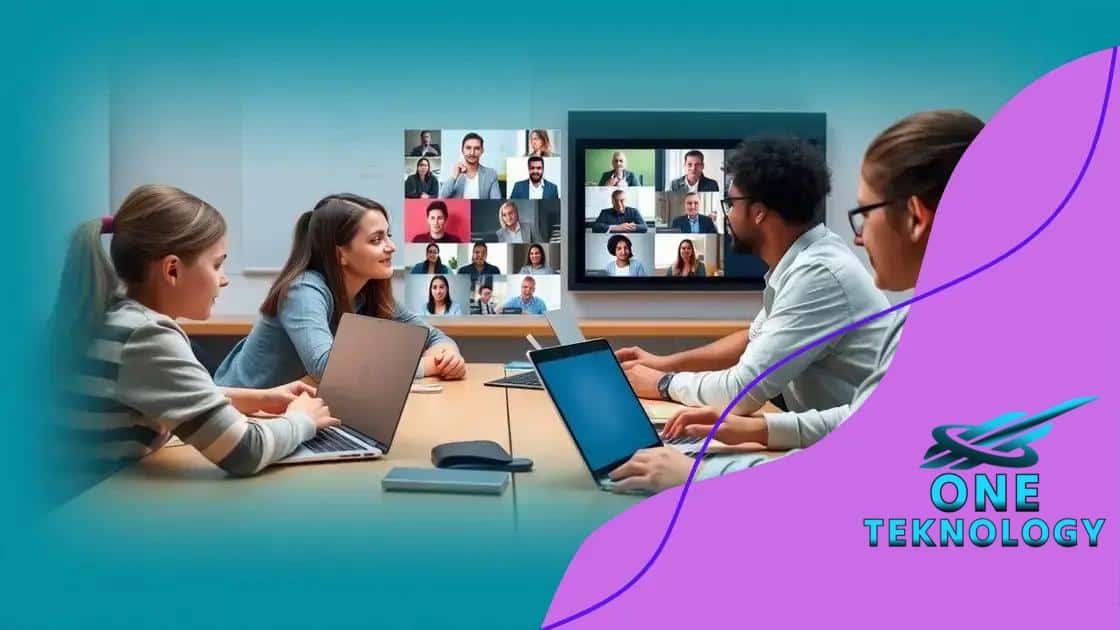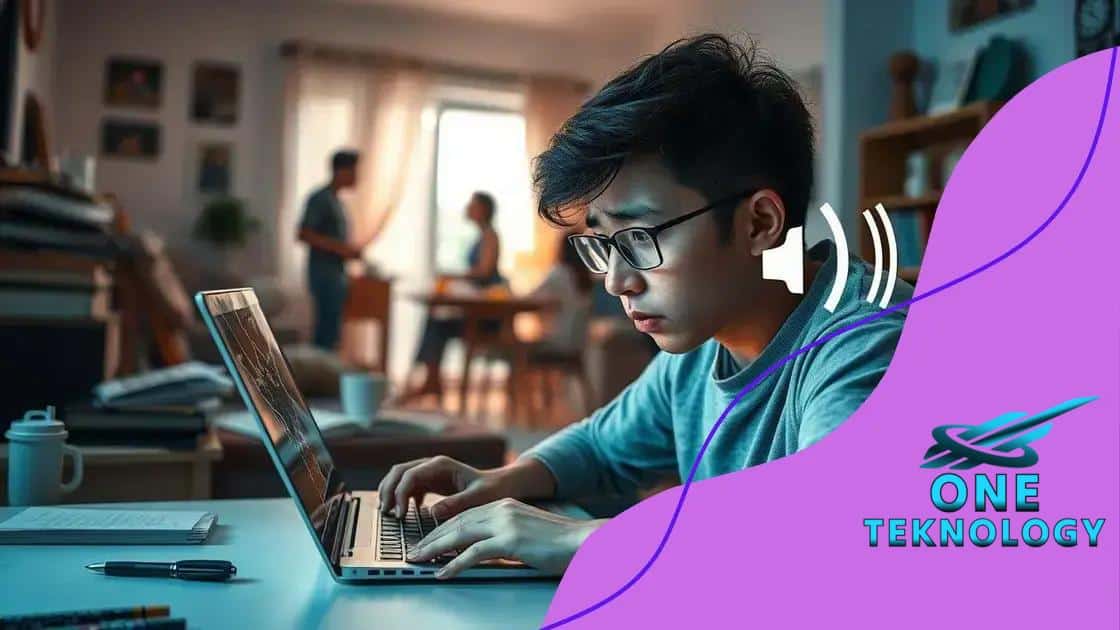The impact of virtual classrooms on student collaboration

The impact of virtual classrooms on student collaboration significantly enhances engagement, access to diverse resources, and global connectivity while also presenting challenges like technical difficulties and distractions.
The impact of virtual classrooms on student collaboration is reshaping the educational landscape. Have you ever wondered how digital spaces influence teamwork among students? Let’s dive in and explore these changes.
Understanding virtual classrooms
Understanding virtual classrooms is essential in today’s educational landscape. These digital spaces provide new opportunities for students to connect, engage, and learn together, regardless of their physical location. Virtual classrooms incorporate various technologies that allow for collaboration and interactive learning experiences.
What Are Virtual Classrooms?
A virtual classroom is an online environment where students and teachers can meet, share resources, and participate in learning activities. These platforms often include tools for video conferencing, discussion boards, and file sharing. They create a space for learning that is both flexible and accessible.
Benefits of Virtual Classrooms
- Increased accessibility for students
- Enhanced collaboration among peers
- Real-time feedback from instructors
- Interactive learning activities and resources
The role of technology in virtual classrooms cannot be underestimated. Tools such as breakout rooms enable small group discussions, while polls and quizzes keep students engaged. These features make learning more lively and interactive, promoting a sense of community among students.
Moreover, virtual classrooms can cater to different learning styles. With a blend of visual, auditory, and kinesthetic activities, every student can find methods that resonate with them. This individualized approach enhances the overall learning experience, making it more effective.
Challenges of Virtual Classrooms
Though there are many positives, there are also challenges to consider. Students may experience technical difficulties or distractions at home that hinder their learning. Additionally, some may struggle to stay motivated in an online setting. Addressing these challenges is crucial for maximizing the potential of virtual classrooms.
By understanding both the benefits and hurdles, educators can better support their students. Creating a supportive learning environment online is key to ensuring that all students thrive in this new educational era.
Benefits of virtual collaboration
The benefits of virtual collaboration are becoming increasingly apparent in educational settings. By leveraging technology, students can work together effectively, even when they are miles apart. This collaboration allows for a diverse range of ideas and perspectives to be shared, enhancing the overall learning experience.
Increased Engagement
One of the key advantages of virtual collaboration is the level of engagement it fosters among students. Unlike traditional classrooms, where some students might feel overlooked, virtual spaces encourage everyone to participate. Interactive tools such as video calls, chat functions, and collaborative documents make it easier to involve all students in discussions.
Flexibility and Convenience
- Students can collaborate from anywhere, at any time.
- Group work can be scheduled to fit various lifestyles.
- Access to a wide range of digital resources enhances collaboration.
- Students can use tools that best suit their learning styles.
The flexibility that comes with virtual collaboration is invaluable. With the ability to connect remotely, students can choose the times and venues that are most convenient for them. This adaptability not only reduces stress but also leads to more productive group interactions. Additionally, collaborating online offers a variety of multimedia resources, enabling students to share documents, videos, and other assets seamlessly.
Another significant benefit is the development of essential skills. While engaging in group projects, students enhance their communication, teamwork, and problem-solving abilities. These skills are invaluable not just in academic settings but also in future workplaces. By practicing within a virtual environment, students prepare themselves for a world where remote collaboration is increasingly common.
Broader Perspectives
Working in virtual teams allows students to interact with peers from diverse backgrounds. This exposure broadens their perspectives, encouraging them to consider different viewpoints and collaborative solutions. Embracing diversity in virtual collaboration fosters a richer learning environment, leading to more innovative and creative outcomes.
Challenges in virtual learning environments

The challenges in virtual learning environments can be significant, even with the benefits they offer. While many students thrive in online settings, others may struggle with the transition. Recognizing and addressing these challenges is essential for fostering a successful learning experience.
Technical Difficulties
One major hurdle is the presence of technical issues. Internet connectivity problems can disrupt classes, making it difficult for students to participate fully. Lagging video or audio can also hinder communication, leaving some students feeling frustrated and isolated.
Distractions at Home
- Noise from family members or pets.
- Accessibility of personal devices like smartphones.
- Lack of a dedicated study space.
- Competing responsibilities like chores or siblings.
Another challenge is distractions that come with learning from home. Students may face interruptions from family members or noise that makes concentration difficult. Additionally, personal devices such as smartphones can lead to distractions, pulling students away from their studies.
Furthermore, not all students have access to a quiet place to study. Some may have to share their space, which can complicate their learning experience. This lack of a structured learning environment can affect their ability to focus and participate actively during lessons.
Maintaining Motivation
Staying engaged in a virtual classroom can sometimes be challenging. Without direct supervision, some students may lack motivation to participate fully. The absence of physical interaction with peers can also lead to a sense of isolation. Many students find it easier to learn when they are with classmates and can share ideas in person.
To combat these challenges, educators and institutions need to be proactive. They can implement strategies to enhance connectivity, create a more engaging online environment, and support students in developing effective study habits. Providing resources and assistance for technical issues can make a significant difference in students’ learning experiences in virtual learning environments.
Tools to enhance collaboration
Using the right tools can significantly enhance collaboration in a virtual classroom. With a variety of platforms and applications available, students and teachers can work together seamlessly, regardless of their locations. These tools make sharing information and ideas easier and more efficient.
Video Conferencing Platforms
Video conferencing tools like Zoom and Google Meet are essential for virtual collaboration. They allow for real-time communication, meaning students can participate in group discussions just as they would in a physical classroom. Features such as screen sharing provide a way for students to present their work or collaborate on projects directly during meetings.
Collaborative Document Editors
- Google Docs
- Microsoft OneNote
- Dropbox Paper
- Quip
Collaborative document editors such as Google Docs and Microsoft OneNote enable multiple students to edit the same document simultaneously. This live collaboration fosters teamwork and ensures that everyone can contribute their ideas and feedback. Moreover, the ability to track changes helps students understand how their group is developing its work.
Another valuable tool is an online project management platform. These tools allow students to organize tasks, set deadlines, and assign responsibilities. Platforms like Trello or Asana simplify the workflow and ensure that everyone involved knows what they need to do. This clarity helps mitigate confusion and keeps projects on track.
Discussion Boards and Forums
Discussion boards facilitate deeper engagement. They provide a space for students to discuss ideas, ask questions, and give feedback outside of live classes. Platforms like Piazza and Slack enable continuous conversation among peers, catering to students who may need more time to formulate their thoughts.
Engaging with peers through these collaboration tools builds a sense of community among students in virtual classrooms. This social interaction is crucial for maintaining motivation and connection, making the learning experience richer and more rewarding.
Future of student collaboration in virtual spaces
The future of student collaboration in virtual spaces looks promising, as technology continues to evolve. As schools and universities adapt to these changes, they open new avenues for collaborative learning. The integration of advanced tools and platforms will enhance how students connect and work together.
Emerging Technologies
New technologies, such as artificial intelligence and virtual reality, are poised to transform the way students collaborate. With AI tools, students can receive personalized learning experiences that cater to their individual needs. Virtual reality can create immersive environments where students feel as though they are learning together in person, no matter where they are.
Enhanced Interactive Learning
- Real-time feedback from peer reviews
- Interactive scenarios for problem-solving
- Gamification of collaborative tasks
- Access to expert mentors and resources
As collaboration tools continue to improve, students will benefit from enhanced interactive learning experiences. Real-time feedback from peers can lead to better understanding and retention of material. Additionally, gamifying collaborative tasks can make learning more engaging and fun, attracting students’ interest.
Online platforms will increasingly enable students to connect with experts and resources that complement their studies. This will provide opportunities for mentoring and real-world applications, further enriching the learning experience.
Increased Global Connectivity
Collaboration in virtual spaces also allows students to engage with their peers from around the world. This global connectivity opens doors to diverse perspectives and ideas that can enhance their understanding of complex subjects. Students who collaborate internationally can learn to appreciate cultural differences and develop stronger communication skills.
As we look to the future, it is clear that student collaboration will continue to evolve in virtual spaces. By leveraging cutting-edge technologies and fostering a global learning environment, students will have greater access to knowledge and opportunities that prepare them for a rapidly changing world.
The future of student collaboration in virtual classrooms will continue to grow and evolve. As technology advances, we can expect even more exciting tools and methods that enhance learning experiences. Students will have enhanced access to resources, tools, and global connections, allowing them to collaborate like never before. By embracing these changes, students are better equipped for their futures in an increasingly digital world. This journey towards effective virtual collaboration holds endless possibilities for all learners. \n\n
\n
FAQ – Questions About Virtual Classrooms and Student Collaboration
What are the main benefits of virtual classrooms for collaboration?
Virtual classrooms enhance collaboration by providing accessible tools that allow students to interact, share resources, and work on projects together in real-time.
How can technology improve student engagement in virtual environments?
Technology such as video conferencing and collaborative document editing encourages participation, helping students feel more connected and involved in their learning.
What challenges do students face in virtual learning environments?
Students may encounter technical difficulties, distractions at home, and a lack of motivation when learning in virtual spaces, which can affect their academic performance.
What tools can students use to enhance collaboration in virtual classrooms?
Students can use tools like Google Docs for document sharing, Zoom for video meetings, and project management platforms like Trello to organize tasks and collaborate effectively.






